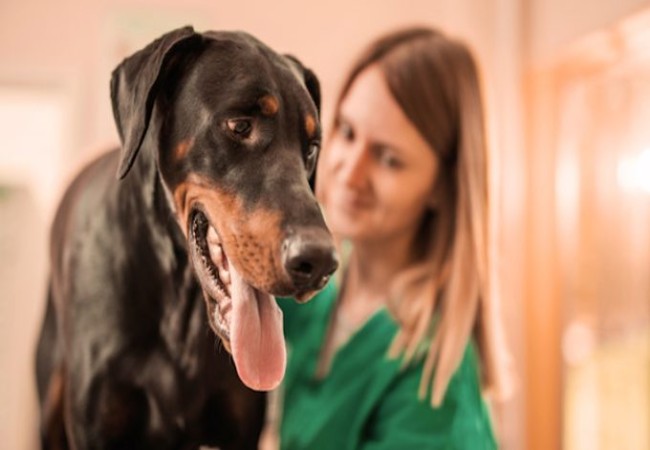Vet’s 2025 Guide to Neosporosis in Dogs Diagnosis, Treatment & Prevention🩺

In this article
Vet’s 2025 Guide to Neosporosis in Dogs: Diagnosis, Treatment & Prevention🩺
By Dr. Duncan Houston BVSc
💡 Introduction
Neosporosis is caused by the protozoal parasite Neospora caninum. Dogs may develop neuromuscular disease—often devastating in puppies—or remain silent carriers, contributing to congenital transmission, reproductive loss, and herd impact in cattle.
1. What Is Neosporosis?
This coccidian parasite infects dogs and wild canids as definitive hosts—shedding oocysts in feces—and a wide range of mammals as intermediate hosts, including cattle, affecting neuromuscular and reproductive health.
2. How Dogs Become Infected
- In utero transmission—common in litters from affected dams.
- Ingestion of infected tissues—raw meat, offal from intermediate hosts.
- Oocyst ingestion—fecal-oral cycle in domestic/wild canids.
3. Who's at Risk?
- Puppies—peak severity with neuromuscular signs, rigid extension, death.
- Adult dogs may show acquired neuromuscular disease, skin lesions, abortion, or remain carriers.
- Dogs exposed via raw diets, particularly wild game or vertical transmission.
4. Classic Clinical Signs
4.1 Juvenile neuromuscular form (usually <6 months)
- Progressive hind limb paresis → paralysis, ascending rigidity, muscle atrophy, arthrogryposis.
- Cervical weakness, difficulty feeding → often fatal without early intervention.
4.2 Adult or acquired form
- CNS signs: ataxia, head tilt, seizures
- Neuromuscular: exercise intolerance, stiffness, dysphagia
- Dermatologic: nodular or ulcerative rash.
- Reproductive: abortion, stillbirth in breeding dogs.
Nonspecific signs—fever, weight loss, anorexia—may accompany systemic infection.
5. Diagnosis in 2025 🧬
5.1 Clinical examination
Identify multipart neuromuscular dysfunction, vertical transmission risk, skin lesions, or reproductive failure.
5.2 Laboratory testing
- Serology: IFA or ELISA—qualifies exposure, helpful in puppies and breeding management.
- PCR: organism DNA detection in blood/CSF/aspirate—confirms active infection.
- CBC/chemistry: elevated CK/AST (muscle damage), liver enzymes, protein abnormalities.
- Diagnostics: EMG, nerve/muscle biopsy, MRI, CSF—to differentiate from other neuromuscular diseases.
6. Treatment & Prognosis
6.1 Antiprotozoal therapy
- Clindamycin 10–20 mg/kg BID for 4–6 weeks; often first-line.
- Sulfa/pyrimethamine combinations as an adjunct in refractory cases.
- Earlier intervention = better neuromuscular recovery—delay often leads to permanent damage.
6.2 Supportive care
- Physiotherapy, passive ROM to reduce contractures
- Nutritional support—assist feeding in puppies
- Anticonvulsants for CNS signs
- Antibiotics/steroids for skin lesions or inflammation
6.3 Prognosis
- Puppies: severely affected may not recover fully; early aggressive treatment improves chances.
- Adults: variable outcomes—partial or full recovery possible; relapse can occur.
- Carriers: may remain asymptomatic but should be managed in breeding programs.
7. Prevention & Breeding Guidance
- Avoid raw meat from ruminants—prevent ingestion by dogs.
- Test breeding dogs—avoid using seropositive individuals for breeding.
- Proper disposal of aborted material disrupts the lifecycle.
- Clean kennels thoroughly to eliminate environmental exposures.
8. Ask A Vet Support 🛡️
- Interactive log for neuro signs, skin lesions, and appetite loss
- Medication reminders for clindamycin and sulfa regimens
- Guided physiotherapy routines to prevent joint complications
- Alerts for urgent signs—collapse, seizures, feeding failure
- Breeding advice and testing coordination for future litters
9. 2025 Research & Emerging Insights
- Better multimodal diagnostic protocols combining serology, PCR, and EMG.
- Adult-onset presentation recognized more often, beyond juvenile paralysis.
- Initial vaccine trials in cattle—future canine vaccines may follow.
🔍 Key Takeaways
- Neosporosis is a major cause of congenital and acquired neuromuscular disease in dogs.
- Diagnosis relies on serology, PCR, imaging, and exclusion of other causes.
- Early antiprotozoal treatment, especially clindamycin, improves outcomes.
- Breeding control and hygiene disrupt lifecycle and reduce congenital spread.
- Ask A Vet enhances home management with tracking, reminders, and guidance.
🩺 Conclusion
Neosporosis can be devastating—but with 2025’s advanced diagnostics, targeted therapy, and prevention strategies, many affected dogs can recover or be managed effectively. As always, early veterinary care and reproductive planning are essential. The Ask A Vet app supports you with real-time care, tracking, and peace of mind during treatment and beyond. 🐾❤️
Dr Duncan Houston BVSc – merging veterinary science with empathetic care to help dogs thrive.
For more support, visit AskAVet.com and download the Ask A Vet app for expert monitoring, medication reminders, and personalized guidance on your dog’s journey. ❤️






